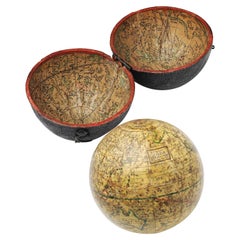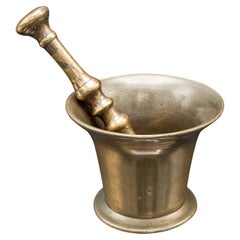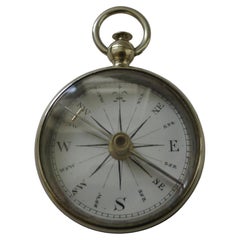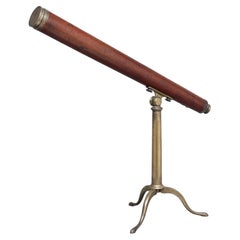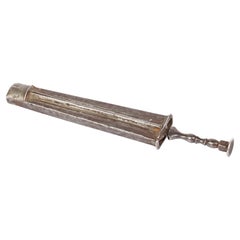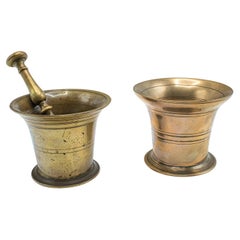Georgian Scientific Instruments
to
3
31
13
45
148
147
137
52
45
36
27
23
16
15
15
6
6
6
4
3
1
1
20
24
1
1
29
27
20
14
6
43
41
30
1
45
45
45
1
1
1
1
1
Style: Georgian
English Pocket Globe, London, Circa 1775-1798
By Herman Moll
Located in Milano, IT
Pocket globe
London, between 1775 and 1798
Re-edition of the globe of Hermann Moll (1678-1732) dated 1719
The globe is contained in its original case, which itself is covered in shark skin.
There are slight gaps in the original paint on the sphere. The case no longer closes.
The sphere measures 2.7 in (7 cm) in diameter whereas the case measures 2.9 in (7.4 cm) in diameter.
lb 0.22 (kg 0.1)
The globe is made up of twelve printed paper gores aligned and glued to the sphere.
In the North Pacific Ocean there is a cartouche with the inscription:
A Correct
Globe
with the new
Discoveries.
The celestial globe is depicted on the inside of the box and is divided into two hemispheres with the cartouche:
A correct globe
with ye new cons
relations of Dr.
Halley & c.
It shows the ecliptic divided into the days of the zodiacal calendar and the constellations represented as animals and mythological figures.
On the globe are delineated the equinoctial line, divided by degrees and hours, the ecliptic and the meridian (passing west of Greenwich). The continents are shaded and outlined in pink, green and yellow. It shows: the Cook routes; a wind rose in the Southern Indian Ocean; Antarctica without land; Africa with Negroland (Hermann Moll is considered the first geographer to name the West African region in his 1727 map. (Encyclopaedia Britannica, ed. 1902, under "States of Central Africa"); Tartary in Central Asia; the Mogul kingdom in northern India; in North America only New England, Virginia, Carolina, Florida, Mississippi are identified; California is already a peninsula; the northwest coast of America is "unknown parts" (Alaska is not described and it is only partially delineated, it was to become part of the United States in 1867); Mexico is named "Spain"; Central South America "Amazone America". Australia (which was to be so named after 1829) is called New Holland. The route of Admiral Anson is traced (1740) and the trade winds are indicated by arrows. (See Van der Krogt, P., Old Globes in the Netherlands, Utrecht 1984, p. 146 and Van der Krogt, P. - Dekker, E., Globes from the Western World, London 1993, pp. 115.)
Elly Dekker, comparing Moll’s 1719 globe and his re-edition (of which the one described above is a sample), identifies the differences between them: the two editions are quite similar to each other, but in the "anonymous" globe, compared to the previous globe of 1719, California looks like a proper peninsula - the reports of the Spanish explorers of the region had given rise to uncertainty over whether it was connected to the mainland or not. The geographical nature of California was confirmed after the explorations of Juan Bautista de Anza (1774-1776). The routes of Dampier's journey were partially erased and the route of Captain James Cook's first voyage was superimposed on them, and the geography of Australasia was adapted accordingly, including the denomination of the Cook Strait. See Dekker, Elly, Globes at Greenwich, 1999.
An important ante quem element is represented by Tasmania: it is not separated from Australia by the Bass Strait...
Category
Late 18th Century English Antique Georgian Scientific Instruments
Materials
Shagreen, Paper
Antique Apothecary Mortar & Pestle, English, Bronze, Chemist Shop Aid, Georgian
Located in Hele, Devon, GB
This is an antique apothecary mortar and pestle. An English, bronze chemist's shop aid, dating to the Georgian period, circa 1800.
Quality Georgian apothecary aid with superb finis...
Category
Late 18th Century British Antique Georgian Scientific Instruments
Materials
Bronze
Antique English Compass In Case With White Enamel Dial; Georgian C.1820
Located in Bath, GB
A charming early little compass with a polished brass case and a perfect white enamelled face or dial. The pin at the top is pulled out to release the needle freely and pushed in aga...
Category
1820s British Antique Georgian Scientific Instruments
Materials
Brass
18th Century mahogany and brass telescope by Nairne & Blunt of London
Located in Martlesham, GB
18th Century mahogany and brass telescope by Nairne & Blunt of London, having a mahogany barrel with a thumb wheel to the side of the main barrel, supported on a solid brass tripod s...
Category
1780s British Antique Georgian Scientific Instruments
Materials
Mahogany
Georgian Rare Steel Cased Tuning Fork
Located in Bishop's Stortford, Hertfordshire
A very unusual and rare Georgian antique steel cased tuning fork dating from around 1800. A wonderful piece of musical interest and history the tuning fork...
Category
Early 1800s English Antique Georgian Scientific Instruments
Materials
Steel
Antique Mortar and Pestle Duo, English, Brass, Apothecary, Jardiniere, Georgian
Located in Hele, Devon, GB
This is an antique mortar and pestle duo. An English, polished brass apothecary dish or decorative jardiniere pot, dating to the Georgian period, circa 1800.
Dashing Georgian morta...
Category
Late 18th Century British Antique Georgian Scientific Instruments
Materials
Brass
George III Mahogany Banjo Barometer Edinburgh
Located in Huntington, NY
George III Mahogany Banjo Barometer By Edie & Son. Edinburgh
Alexander James Adie FRSE MWS (7 November 1775, Edinburgh – 4 December 1858, Edinburgh) was a Scottish maker of medical ...
Category
Late 18th Century English Antique Georgian Scientific Instruments
Materials
Brass
18th Century English Treen Yew Wood Mortar and Pestle
Located in Stamford, CT
18th century English treen mortar and pestle hand turned and carved from yew wood with the rich and warm patina that only comes with age and use. Beautifully carved by hand from a si...
Category
Mid-18th Century English Antique Georgian Scientific Instruments
Materials
Yew
George III Oversized Magnifying Glass Late Circa 1790
Located in Bishop's Stortford, GB
George III Oversized Magnifying Glass Late Circa 1790. Comprised of a turned mahogany surround holding 20 cm lens with a turned mahogany handle connected by a generous brass ferrule ...
Category
Late 18th Century European Antique Georgian Scientific Instruments
Materials
Brass
Pocket Globe by Nathaniel Hill, London 1754
Located in Milano, IT
Nathaniel Hill
Pocket globe
London, 1754
The globe is contained in its original case, which itself is covered in shark skin.
There are slight gaps in the original paint on the sphere. The case no longer closes.
The sphere measures 2.6 in (6.8 cm) in diameter whereas the case measures 2.9 in (7.4 cm) in diameter.
lb 0.24 (kg 0.11)
The globe is made up of twelve printed paper gores aligned and glued to the sphere.
In the North Pacific Ocean there is a scroll with the inscription:
A
New
terrestrial
Globe
by
Nath. Hill,
1754.
The celestial globe is depicted on the inside of the box.
On the terrestrial globe much of central and southern Africa is empty. North America bears only the name of some British colonies. It shows California as a peninsula and the northwest coast of America as "unknown parts" (Alaska is not described and is only partially delineated; it would become part of the United States in 1867). The route of Admiral Anson is traced (1740) and the trade winds are indicated by arrows. Australia, still named New Holland (the new name would be introduced in 1829), is part of the west coast. (See Van der Krogt, P., Old Globes in the Netherlands, Utrecht 1984, p. 146 and Van der Krogt, P. - Dekker, E., Globes from the Western World, London 1993, p. 115.)
Nathaniel Hill (London, news from 1746 to 1768) had impeccable professional credentials: he had done his apprenticeship with Richard Cushee, who at the time was carrying out surveying work for John Senex's Surrey map...
Category
1750s English Antique Georgian Scientific Instruments
Materials
Shagreen, Paper
English Mahogany Stick Barometer Signed T. Taylor London
Located in Savannah, GA
Stick Barometer signed T. Taylor London featuring mahogany case with bone plinth, inlay and knob. Broken arch pediment above a flush-glass door, enclosing register plate and thermometer. Fully restored and calibrated by Julian Gibbard, Harpers Ferry...
Category
Early 1800s English Antique Georgian Scientific Instruments
Materials
Brass
Antique Kitchen Mortar & Pestle, English, Bronze, Apothecary, Chemist, Georgian
Located in Hele, Devon, GB
This is an antique kitchen mortar and pestle. An English, bronze apothecary or chemist's shop aid, dating to the Georgian period, circa 1780.
Useful kitchen or apothecary aid from ...
Category
Late 18th Century British Antique Georgian Scientific Instruments
Materials
Bronze
English Stick Barometer by Worthington of London
Located in New Orleans, LA
This exceptional English stick barometer is a classic example of these intriguing meteorological instruments. Crafted by the esteemed Worthington & All...
Category
19th Century English Antique Georgian Scientific Instruments
Materials
Mahogany
Antique George III Quality Mahogany Banjo Barometer
Located in Suffolk, GB
Antique George III quality mahogany banjo barometer having a quality mahogany shaped case with a swan neck pediment and satinwood stringing, circular silvered engraved dial with orig...
Category
Early 1800s English Antique Georgian Scientific Instruments
Materials
Mahogany
Very Large George III Rosewood Gallery Magnifying Glass
Located in Lymington, Hampshire
A very large George III rosewood gallery magnifying glass, the circular glass within a rosewood frame, the baluster handle screwing into a brass bra...
Category
Early 19th Century English Antique Georgian Scientific Instruments
Materials
Brass
Antique Three-Draw Telescope, English, Walnut, Brass, Navigation, Georgian, 1790
Located in Hele, Devon, GB
This is an antique three-draw telescope. An English,walnut and brass navigational or astronomical instrument by Lincoln of London, dating to the Georgian period, circa 1790.
Perfect for bird watching, landscape appreciation, wildlife, or maritime observation. Equally suitable for observing the night sky.
A fine and tactile example of Georgian optical craftsmanship
Crafted with a striking walnut main barrel, displaying warm amber tones
Walnut exhibits a fine grain pattern, with minimal wear commensurate with gentle use
Features three smoothly operating brass draw tubes, with bright golden hues
Engraved to the rear barrel with 'Lincoln, London' – a noted maker of the period
Fitted with a push-type dust cover to protect the 40mm primary objective lens
Bright, functional optics with a clear image – suited for both display and gentle use
A handsome piece for the collector of nautical antiques or scientific instruments
Supplied with a London Fine oak and brass 'Captain's Stand' for display
Further enhanced with the original leather carry sleeve, in lightly time worn order
Elegant and evocative, this Georgian telescope...
Category
1790s British Antique Georgian Scientific Instruments
Materials
Brass
Late 18th Century Lacquered Brass Table Telescope
Located in Huntington, NY
Late 18th century lacquered brass table telescope.
Category
Late 18th Century English Antique Georgian Scientific Instruments
Materials
Brass
$4,368 Sale Price
20% Off
John Bennett Georgian Barometer
By John Bennett
Located in New Orleans, LA
This exceptional Georgian barometer by the leading London instrument-maker John Bennett strongly reflects the prevalent furniture style and archite...
Category
18th Century English Antique Georgian Scientific Instruments
Materials
Brass
Large Bronze Imperial Standard Bushel Measure For Northumberland
Located in Essex, MA
Circular with wood bound handles and inscribed Bate London " Maker of The Original Standards For The Exchequer , City Of London " . Imperial Standard Bushel Measure for Northumberla...
Category
1820s English Antique Georgian Scientific Instruments
Materials
Bronze
A fine late Georgian mahogany waywiser by Alfred Joy, Chichester
Located in Lymington, Hampshire
A fine late Georgian mahogany waywiser by Alfred Joy, Chichester, comprising a revolving wheel connected to a recording dial marked in yards and poles on one scale and in furlongs an...
Category
Early 19th Century English Antique Georgian Scientific Instruments
Materials
Mahogany
Antique Telescope, Large, Single Draw Refractor, Cary London, circa 1820
Located in Hele, Devon, GB
This is an antique telescope, a large single draw refractor for terrestrial or astronomical use. An English, late Georgian piece dating to circa 1820.
Perfect for bird watching, landscape appreciation, wildlife, or maritime observation. Equally suitable for observing the night sky. Supplied ready to enjoy; Fully inspected and lenses cleaned by our in-house restorer.
Larger than most presenting a clear, sharp optical performance
Tapered, original painted, primary barrel in good order
Draw tube in good order with smooth action
56mm, 2.25" objective lens
Presents a good, sharp and bright image
Engraved 'Cary, London'
Complete with lens CAP and swivel dust cover
Supplied with an London Fine oak and brass 'Captain's Stand' for display
An historic, period piece as good to use today as it was two hundred years ago.
Dimensions:
Max Drawn Length: 112cm (44''
Closed Length: 76cm (30'')
Objective Glass Diameter: 5.6cm (2.25'')
About Cary, The Stand, London
William Cary was born in 1759, the third of four brothers to George and Mary Cary. The eldest, George, was a haberdasher, John a map maker and the youngest, Francis, an engraver.
William served his apprenticeship under Jesse Ramsden, arguably one of the finest instrument makers in England, and went on to produce Fine instruments himself, working alongside his brother John. They produced telescopes, microscopes, navigation and surveying equipment, mechanical calculators...
Category
Early 19th Century English Antique Georgian Scientific Instruments
Materials
Brass
Signed 19th Century Mahogany and Brass Telescope on Custom Oak Wall Mount
Located in San Francisco, CA
An English mahogany and brass single draw telescope made and signed by William Bruce, Kings Head Court Shoe Lane London, circa 1830. This handsom...
Category
1830s English Antique Georgian Scientific Instruments
Materials
Brass
$1,160 Sale Price
20% Off
Rare George III Celestial Pocket Globe by Cary, London
By Cary
Located in Oxfordshire, United Kingdom
A fine and rare 3" celestial pocket globe by G & W Cary, Strand, London circa 1791, housed in its original sharkskin case.
A companion globe to terrestrial globes of this type we...
Category
Late 18th Century English Antique Georgian Scientific Instruments
Materials
Plaster
English Mahogany 19th Century Stick Barometer by Tarone
Located in Vero Beach, FL
English Mahogany 19th Century Stick Barometer by Tarone
Classic traditional English mahogany stick Barometer. Excellent and original feat...
Category
19th Century English Antique Georgian Scientific Instruments
Materials
Silver
English Brass Urn & Marble Base Scale . Circa 1815
Located in Charleston, SC
English brass scale with centered urn , feather pointer , brass pans, marble base , and terminating on brass ball feet. All original . Early 19t...
Category
1810s English Antique Georgian Scientific Instruments
Materials
Marble, Brass
17th Century Tripod Apothecary Skillet Dated 1698 from The Ward Rvmens Family
Located in Brussels, Brussels
17th century tripod apothecary skillet dated 1698 by Ward Rymens.
The skillet is in superb condition and has had a restoration on one of the feet.
bronze with a very beautiful patina.
Category
17th Century British Antique Georgian Scientific Instruments
Materials
Bronze
18th Century English Mahogany Cased Stick Barometer by Dolland of London
By Dolland
Located in Dublin, IE
An exceptional late 18th century mahogany cased stick barometer by Dolland of London, The mahogany case of a very solid construction and with a superbly made turned mahogany cistern ...
Category
1790s English Antique Georgian Scientific Instruments
Materials
Steel
George III Mahogany Mercury Stick Barometer by Henry Andrews, Royston
Located in Norwich, GB
George III stick barometer in a finely figured mahogany case with canted corners and architectural pediment surmounted by a central ivory finial. Exposed mercury tube with bulb ciste...
Category
Early 1800s English Antique Georgian Scientific Instruments
Materials
Mahogany
Early 19th Century Antique George III Mahogany Stick Barometer by Cremonino
Located in Devon, GB
A fine and well-proportioned early 19th century figured mahogany barometer signed ‘Cremonino, Fecit.’
This barometer has a broken arch pediment above a flush-glass door, enclosing ...
Category
Early 19th Century English Antique Georgian Scientific Instruments
Materials
Mahogany
Important Georgian Mahogany Mercury Stick Barometer by Stott, Dumfries
Located in Norwich, GB
Fine Georgian mahogany bow fronted stick barometer. Bow fronted glass set in front of the silvered register plate with sliding vernier controlled by an ivory turned knob. Concertina ...
Category
1790s English Antique Georgian Scientific Instruments
Materials
Mahogany, Ivory
English Mahogany Prince of Wales Banjo Barometer, Circa 1820
Located in Charleston, SC
English mahogany four dial banjo barometer with broken arch pediment, steel engraved face with Prince of Wales motif, and original rotating bone dial. Barometer can be restored to wo...
Category
1820s English Antique Georgian Scientific Instruments
Materials
Steel
19th Century Dental Tool Kit
Located in London, GB
19th century dental tool kit
A rare set of 19th century dental tool kit, all tools are encased in a wooden box with brass latch and lined with a worn red...
Category
19th Century British Antique Georgian Scientific Instruments
Materials
Metal
Antique George III Quality Mahogany Shell Inlaid Banjo Barometer
Located in Suffolk, GB
Antique George III quality mahogany shell inlaid banjo barometer having a quality mahogany banjo shaped case with satinwood shell inlay, brass bezel, silvered engraved dial, original...
Category
19th Century English Antique Georgian Scientific Instruments
Materials
Other
Lignum Vitae Treen Vices Pair of Minature Tree of Life
Located in BUNGAY, SUFFOLK
- Collector's specimens
- Lignum vitae is sought after for the beauty of its grain, coloring, patina, density and toughness
Translated from Latin, vignum vitae means “wood of lif...
Category
1750s English Antique Georgian Scientific Instruments
Materials
Wood
19th Century Antique English Mahogany Marine Barometer signed Nixon
By Nixon
Located in Devon, GB
An early 19th century mahogany marine barometer of exceptional quality and originality. The elegant carved, fluted and turned case has an inset engrav...
Category
19th Century British Antique Georgian Scientific Instruments
Materials
Mahogany
Antique George III Quality Mahogany Inlaid Banjo Barometer
Located in Suffolk, GB
Antique George III quality mahogany inlaid banjo barometer having a swan neck top, quality mahogany case with inlaid satinwood shells brass bezel engraved silvered dial original hand...
Category
19th Century English Antique Georgian Scientific Instruments
Materials
Other
George III Banjo Mahogany Barometer by R. Taylor, Chepstow, England c. 1820
By R. Taylow
Located in Atlanta, GA
A Four-dial Barometer/Thermometer in Mahogany, dating from the George III period, and English in origin. Signed at the base "R. Taylor Chepstow". The barometer with swan neck pedim...
Category
Early 19th Century English Antique Georgian Scientific Instruments
Materials
Brass
Antique George III Quality Mahogany Banjo Barometer
Located in Suffolk, GB
Antique George III quality mahogany banjo barometer having a quality mahogany shaped case with a swan neck pediment and satinwood stringing, circular silvered engraved dial with orig...
Category
Early 1800s English Antique Georgian Scientific Instruments
Materials
Mahogany
Mid-Century Georgian Style German Wall Barometer
Located in Germantown, MD
A 1960s decorative Georgian Style wall Barometer from West Germany. 28" tall.
Category
Mid-20th Century German Georgian Scientific Instruments
Materials
Wood
19th Century Antique English Georg III Mahogany Barometer
Located in VALENZA, IT
A fine quality example of a mercury wheel barometer. A mahogany case. A wider and deeper case with an opening door for the long scale thermometer with silvered dial.
A silvered engraved dial signed 'J.B.Sala, Holborn'. Circa 1820.
The banjo barometer is also known as the wheel barometer. It was invented by Robert Hooke...
Category
1810s English Antique Georgian Scientific Instruments
Materials
Mahogany
$1,710 Sale Price
20% Off
Tripod Apothecary Skillet from the 18th Century England
Located in Brussels, Brussels
18th Century tripod Apothecary skillet From England.
The skillet is in superb condition and has not undergone any restorations.
Bronze with a very beautiful patina.
Category
Early 18th Century British Antique Georgian Scientific Instruments
Materials
Bronze
English Antique George II Mahogany Stick Barometer by Polti of Exeter
By C. Polti
Located in Devon, GB
A rare George II period mahogany stick barometer with finely carved cistern cover and surround to partly conceal the mercury tube. Most unusually the signed register plate is made of...
Category
Mid-18th Century English Antique Georgian Scientific Instruments
Materials
Brass
Early 19th Century Butchers Steelyard for Weighing Scale
Located in Godshill, Isle of Wight
Early 19th century butchers steelyard for weighing scale.
A good original industrial piece, the balance has blacksmith made sliding hook for adjustm...
Category
Early 19th Century Antique Georgian Scientific Instruments
Materials
Iron
Early 19th Century Butchers Steelyard for Weighing Scale
Located in Godshill, Isle of Wight
Early 19th Century Butchers Steelyard for weighing scale
A good original industrial piece, the balance has blacksmith made sliding hook for adjustme...
Category
Early 19th Century Antique Georgian Scientific Instruments
Materials
Iron
Tripod Apothecary Skillet Late 17th-Early 18th Century, England
Located in Brussels, Brussels
Apothecary tripod skillet from the end of the 17th century beginning of the 18th century From England.
The skillet is in superb condition and has not undergone any restorations.
Br...
Category
Early 18th Century British Antique Georgian Scientific Instruments
Materials
Bronze
Georgian scientific instruments for sale on 1stDibs.
Find a broad range of unique Georgian scientific instruments for sale on 1stDibs. Many of these items were first offered in the Mid-20th Century, but contemporary artisans have continued to produce works inspired by this style. If you’re looking to add vintage scientific instruments created in this style to your space, the works available on 1stDibs include more furniture and collectibles, decorative objects, wall decorations and other home furnishings, frequently crafted with wood, mahogany and other materials. If you’re shopping for used Georgian scientific instruments made in a specific country, there are Europe, United Kingdom, and England pieces for sale on 1stDibs. While there are many designers and brands associated with original scientific instruments, popular names associated with this style include Arval Argenti Valenza, Cary, London, Cary’s, and Dolland. It’s true that these talented designers have at times inspired knockoffs, but our experienced specialists have partnered with only top vetted sellers to offer authentic pieces that come with a buyer protection guarantee. Prices for scientific instruments differ depending upon multiple factors, including designer, materials, construction methods, condition and provenance. On 1stDibs, the price for these items starts at $395 and tops out at $30,131 while the average work can sell for $2,911.
Recently Viewed
View AllMore Ways To Browse
Marine Barometer
Thomas Edison Furniture
Used Balance Beam Scale
Used Stanley Tools
Vintage Molecular Model
W And T Avery Scales Antique
Wooden Instrument Case
16th Century Bronze Mortar
Anatomical Wax
Antique Brass Ruler
Antique Brass Scoop
Antique Magnetic Compass
Antique Monocular
Antique Oil Pumps
Antique Pocket Compass
Antique Portuguese Scales
Antique Surveyor Compass
Avery Brass Scales
